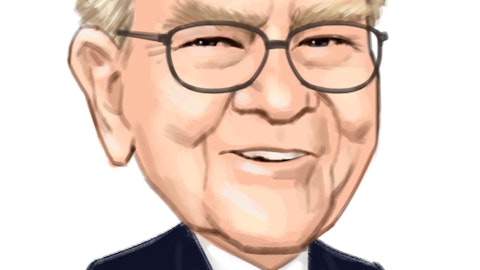Again, what’s keeping that consumer base going is a broad-based wage increase that has helped fuel that. So even though they may have spent the dollars that they got during the pandemic, stimulus packages, they do see larger wage gains. So again, what we’re continuing to see is why the transaction values area little bit lower for them, the frequencies up and they’re continuing to spend it. We think a very a very manageable pace. Again, when we look at our book and I look at the average balance in our book for — if you look at ‘19 versus now, it’s up a CAGR 5%, and the open buys up a little bit more. So I think the consumer is being relatively disciplined and there is more liquidity in the system for them. Clearly, when we look at a high-end consumer, the high-end consumer is performing incredibly well.
Their payment rates remain above 2019 levels. They are showing strength. We’ve skewed in high end of prime up probably 3 percentage points in the super high end, which also has helped the portfolio performance. So again, we feel good and again, when I look at the entire portfolio entry into delinquency is still below 2019 levels.
Operator: Thank you. We’ll take our next question from Rick Shane with JP Morgan. Please go ahead.
Rick Shane: Most have been asked and answered, but I just want to talk a little bit more about the RSA guide, and the improvement there. When we look at the charge off rate, when we look at NIM, when we look at everything, it looks like everything is kind of within the range, but o of expectations, both from an original perspective at the beginning of the year and from a second quarter perspective. But for whatever reason, you feel like the RSA charge is going to be down a little bit is that really just a function of mix or what else is contributing to that?
Brian Wenzel: It really is mixed between the platforms and between the portfolios and their each of these arrangements are different. They’re unique by partners, so certain partners are performing better than others. Certain ones have volume-based measures as well. So it really depends upon where that volume goes and the performance of the individual portfolio. So, that is the main driver.
Operator: Thank you. And we will take our next question from Saul Martinez with HSBC.
Saul Martinez: Most of my questions have been asked, but maybe if you could just go back to your comments on reserve levels and reserve adequacy and where we go from here. I get that your reserves, you seem to be indicating that, that you feel comfortable with your reserve ratios and you are, I think still about 40, 50 basis points, if I’m not mistaken, above your day one CECL allowance levels. But you are expecting NCOs to normalize and, and move higher. I would expect your losses that’ll flow through your reasonable supportable period will be moving higher as we move forward. But just maybe you can comment on your reserve outlook going forward and what would induce you to maybe build reserves. What would need to happen for some additional reserve builds above and beyond what you need for growth?
Brian Wenzel: So, the way I would think about the reserve as we move forward is you should see a rotation as you stabilize in delinquencies in this normalization period that the quantitative model absorbs that trend line. And then as we get more comfortable with the macro backdrops, the effects of inflation, as student loans, if they have an impact flow through the portfolio, you’ll see the qualitative piece begin to come down, and effectively offset that and then you’ll move down. Ultimately, we think towards that day one level. If the assumptions come in generally as we think about it, if you think about incremental provisioning on a rate basis here, again, most of the times we’re talking about things that are growth driven in the portfolio, but truly rate driven ones.
The couple of factors that we look at is clearly if you have a deterioration in collection performance that could do it mainly that’s associated a lot of times with unemployment claims rising. So, that could be a second factor that kind of goes in there. But collection, performance and unemployment claims are two of probably the bigger ones that we’d see. Again, we haven’t seen trends in collections that would warrant that today. So, we feel good about that. And unemployment claims have still remained historically low. So again, we think we factored into our reserve at the end of the third quarter qualitative as assessments for a potentially deteriorating macro, and we’ll just have to see how that plays out.
Operator: And we are allotted time for questions today. So we will take our final question from Arren Cyganovich with Citi.
Arren Cyganovich: Thanks. I’ll be quick, look like your share buybacks came down just a touch. You talk about the, your outlook for buybacks in the quarters ahead.
Brian Wenzel: Yes. First of all, Arren, glad we were able to get your question in. With regard to the backs, we generally do not give or we have not given quarterly guidance with regard to how their purchase flow out for the quarter. At the end of the quarter, we had $850 million remaining under the current share repurchase authorization as we move to the end of the capital year in June of next year. What I probably want to be clear about with regard to that level for a second is what’s not really driving the dollar amount. So I just really want to be clear that it’s not related to a change in the macro environment for us, number one. Two, it’s not related to any potential proposals on late fees. And then three, it’s not related to Basel III end game.
We have a set of mile markers that we’ve set out in the capital plan that’s more RWA based and then how our income kind of comes in versus planned. So those are the factors. And again, we consider the other factors but that was not purchases.
Operator: Thank you. And this concludes Synchrony’s earnings conference call. You may disconnect your lines at this time, and have a wonderful day. Thank you.
Follow Synchrony Financial (NYSE:SYF)
Follow Synchrony Financial (NYSE:SYF)
Receive real-time insider trading and news alerts




